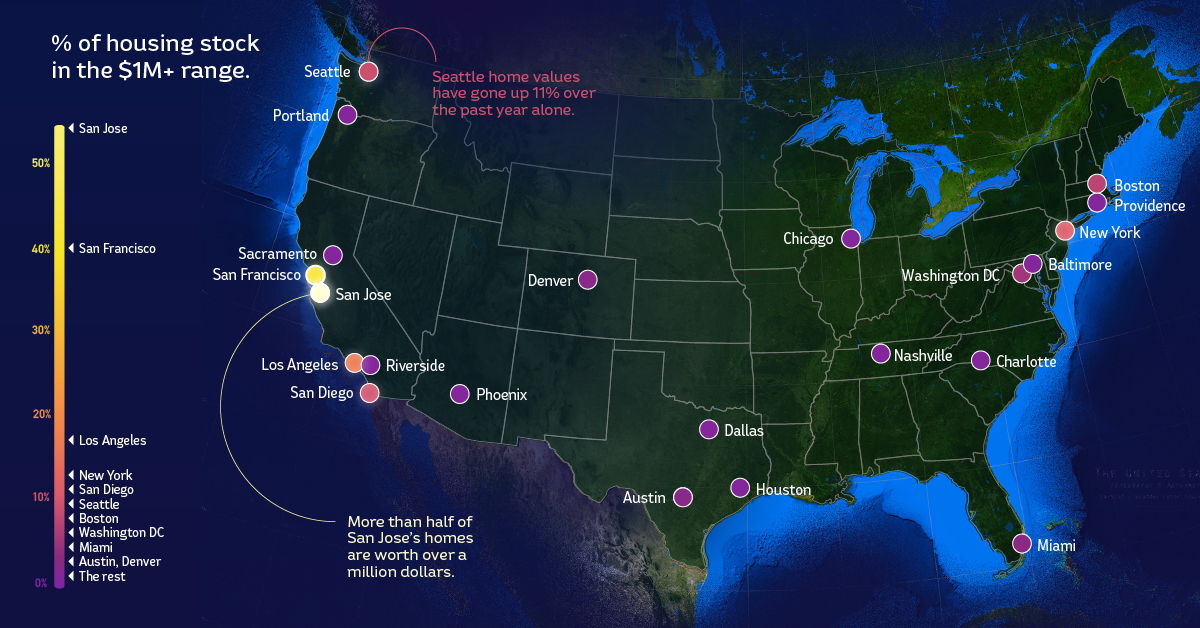But along the coasts – and particularly in California – the two comma club has lost most of its novelty. That’s because in some places, like San Jose, CA, the majority (53.8%) of homes are already soaring past the $1 million mark, despite most of them looking nothing more than ordinary.
$1 Million Homes by City
Today’s chart uses data from a study by LendingTree, which ranks the largest 50 U.S. cities by the percentage of million dollar homes in each metro area. The data from the study was pulled out of a database of 155 million property prices throughout the country. Here are the 22 U.S. cities that have at least 1% of their housing stock exceeding the $1 million value mark: The data looks pretty telling, with four of the top five cities being located in California. In each of those cities, more than 10% of all homes have surpassed the $1 million mark. In the Bay Area specifically, prices are amplified even further: San Francisco (40.0%) and San Jose (53.8%) have by far more $1 million homes than other major cities in the country. It’s also worth noting that in San Jose, the median price of all homes is a whopping $1,069,000. You can just imagine what houses might cost in some of the Silicon Valley towns like Mountain View or Palo Alto, or just over the Golden Gate Bridge in Marin County.
The Bottom of the List
While the above chart shows the 22 U.S. cities with the most $1 million homes, LendingTree also listed the major cities in the country with the fewest. Buffalo, located in upstate New York, takes this title, with only 0.10% of homes passing the mark and an overall median home price of just $141,000. So, to buy the average home in San Jose, you’d need to sell off about eight average houses in Buffalo. The other cities with the smallest concentrations of million dollar homes are also located in the Great Lakes and Midwest regions: Pittsburgh (0.17%), Hartford (0.18%), Cleveland (0.19%), and Indianapolis (0.27%). on Both figures surpassed analyst expectations by a wide margin, and in January, the unemployment rate hit a 53-year low of 3.4%. With the recent release of February’s numbers, unemployment is now reported at a slightly higher 3.6%. A low unemployment rate is a classic sign of a strong economy. However, as this visualization shows, unemployment often reaches a cyclical low point right before a recession materializes.
Reasons for the Trend
In an interview regarding the January jobs data, U.S. Treasury Secretary Janet Yellen made a bold statement: While there’s nothing wrong with this assessment, the trend we’ve highlighted suggests that Yellen may need to backtrack in the near future. So why do recessions tend to begin after unemployment bottoms out?
The Economic Cycle
The economic cycle refers to the economy’s natural tendency to fluctuate between periods of growth and recession. This can be thought of similarly to the four seasons in a year. An economy expands (spring), reaches a peak (summer), begins to contract (fall), then hits a trough (winter). With this in mind, it’s reasonable to assume that a cyclical low in the unemployment rate (peak employment) is simply a sign that the economy has reached a high point.
Monetary Policy
During periods of low unemployment, employers may have a harder time finding workers. This forces them to offer higher wages, which can contribute to inflation. For context, consider the labor shortage that emerged following the COVID-19 pandemic. We can see that U.S. wage growth (represented by a three-month moving average) has climbed substantially, and has held above 6% since March 2022. The Federal Reserve, whose mandate is to ensure price stability, will take measures to prevent inflation from climbing too far. In practice, this involves raising interest rates, which makes borrowing more expensive and dampens economic activity. Companies are less likely to expand, reducing investment and cutting jobs. Consumers, on the other hand, reduce the amount of large purchases they make. Because of these reactions, some believe that aggressive rate hikes by the Fed can either cause a recession, or make them worse. This is supported by recent research, which found that since 1950, central banks have been unable to slow inflation without a recession occurring shortly after.
Politicians Clash With Economists
The Fed has raised interest rates at an unprecedented pace since March 2022 to combat high inflation. More recently, Fed Chairman Jerome Powell warned that interest rates could be raised even higher than originally expected if inflation continues above target. Senator Elizabeth Warren expressed concern that this would cost Americans their jobs, and ultimately, cause a recession. Powell remains committed to bringing down inflation, but with the recent failures of Silicon Valley Bank and Signature Bank, some analysts believe there could be a pause coming in interest rate hikes. Editor’s note: just after publication of this article, it was confirmed that U.S. interest rates were hiked by 25 basis points (bps) by the Federal Reserve.















